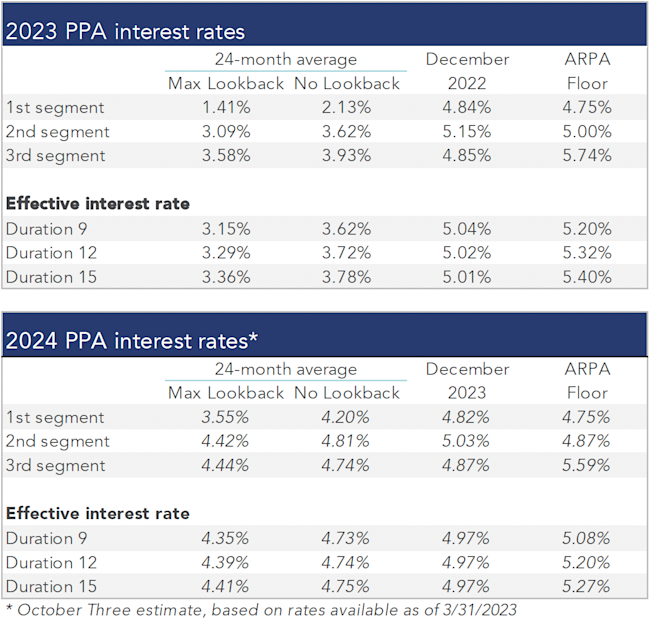Pension Finance Update March 2023
Our latest update on pension plan performance in the first quarter of 2023 highlights a decline in finances due to falling interest rates in March. Despite this, stocks had a solid quarter overall. Our analysis also looks at the rise in pension liabilities and the impact of recent legislation providing pension funding relief. For more information, read our full update.
Pension finances slipped in March as interest rates moved lower, outpacing modestly rising stock prices. Both model plans we track1 saw declines last month: Plan A lost more than 1% in March but remains up more than 1% for the year, while the more conservative Plan B lost less than 1% last month but is still up a fraction of 1% through the first quarter of 2023:

Assets
Most flavors of stocks gained ground in March, ending a solid quarter for stocks generally. A diversified stock portfolio added almost 3% last month and is up more than 8% for the year through March:

Interest rates fell by more than a quarter point last month. As a result, bonds gained 3%-4% last month, ending the first quarter of 2023 up 3%-6%, but remain up about 1% for the year, with long duration bonds performing best so far this year.
Overall, both plans we track gained about 3% during March. For the year, the traditional Plan A is up 6% while the more conservative Plan B has improved 4% through the end of the first quarter.
(1) Plan A is a traditional plan (duration 12 at 5.5%) with a 60/40 asset allocation, while Plan B is a largely retired plan (duration 9 at 5.5%) with a 20/80 allocation with a greater emphasis on corporate and long-duration bonds. We assume overhead expenses of 1% of plan assets per year, and we assume the plans are 100% funded at the beginning of the year and ignore benefit accruals, contributions, and benefit payments in order to isolate the financial performance of plan assets versus liabilities.
Liabilities
Pension liabilities (for funding, accounting, and de-risking purposes) are driven by market interest rates. The first graph below compares our Aa GAAP spot yield curve at December 31, 2022 and March 31, 2023, and it also shows the movement in the curve last month. The second graph below shows our estimate of movements in effective GAAP discount rates for pension obligations of various duration so far this year. Rates at different durations are nearly identical, underscoring the “flatness” of the current yield curve:

Corporate bond yields fell 0.3% in March. As a result, pension liabilities rose 3%-4% during the month, ending the quarter 4%-6% higher.
Summary
The first quarter of 2023 was a see-saw affair, as the Fed tried to push interest rates higher and the markets weren’t having it. Interest rates are still close to 5%, but they have fallen more than 0.75% from levels in late October 2022. Stocks and bonds moved together during the quarter, which saw modest improvement for most pension sponsors, The graphs below show the movement of assets and liabilities during the first quarter of 2023:

Looking Ahead
Pension funding relief was signed into law during March of 2021, and additional relief was provided by November 2021 legislation. The new laws substantially relaxed funding requirements over the next several years, but the increase in rates seen in the past year has eroded the impact of relief.
Discount rates moved 0.3% lower last month. We expect most pension sponsors will use effective discount rates in the 4.7%-4.9% range to measure pension liabilities right now.
The table below summarizes rates that plan sponsors are required to use for IRS funding purposes for 2023, along with estimates for 2024. Pre-relief, both 24-month averages and December ‘spot’ rates, which are still required for some calculations, such as PBGC premiums, are also included.

